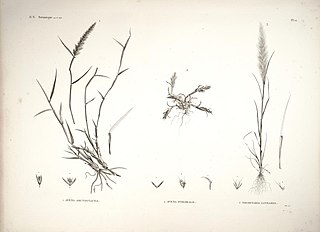
The Andropogoneae, sometimes called the sorghum tribe, are a large tribe of grasses (family Poaceae) with roughly 1,200 species in 90 genera, mainly distributed in tropical and subtropical areas. They include such important crops as maize (corn), sugarcane, and sorghum. All species in this tribe use C4 carbon fixation, which makes them competitive under warm, high-light conditions.

The Bambuseae are the most diverse tribe of bamboos in the grass family (Poaceae). They consist of woody species from tropical regions, including some giant bamboos. Their sister group are the small herbaceous bamboos from the tropics in tribe Olyreae, while the temperate woody bamboos (Arundinarieae) are more distantly related. The Bambuseae fall into two clades, corresponding to species from the Neotropics and from the Paleotropics.

Chloridoideae is one of the largest subfamilies of grasses, with roughly 150 genera and 1,600 species, mainly found in arid tropical or subtropical grasslands. Within the PACMAD clade, their sister group is the Danthonioideae. The subfamily includes widespread weeds such as Bermuda grass or goosegrass, but also millet species grown in some tropical regions, namely finger millet and teff.

Panicoideae is the second-largest subfamily of the grasses with over 3,500 species, mainly distributed in warm temperate and tropical regions. It comprises some important agricultural crops, including sugarcane, maize, sorghum, and switchgrass.

The Arundinoideae are a subfamily of the true grass family Poaceae with around 40 species, including giant reed and common reed. Unlike many other members of the PACMAD clade of grasses, the Arundinoideae all use C3 photosynthesis. Their sister group is the subfamily Micrairoideae.

Eragrostideae is a tribe of grasses in subfamily Chloridoideae. It contains roughly 500 species, which all use the C4 photosynthetic pathway.

The Stipeae are a tribe of grasses within the subfamily Pooidae, with up to 600 described species.

Oryzoideae (syn. Ehrhartoideae) is a subfamily of the true grass family Poaceae. It has around 120 species in 19 genera, notably including the major cereal crop rice. Within the grasses, this subfamily is one of three belonging to the species-rich BOP clade, which all use C3 photosynthesis; it is the basal lineage of the clade.

Danthonioideae is a mainly southern hemisphere subfamily of grasses, containing the single tribe Danthonieae and one unplaced genus, with altogether roughly 300 species. It includes herbaceous to partially woody perennial or annual (less common) grasses that grow in open grasslands, shrublands, and woodlands. It belongs to the PACMAD clade of grasses, but unlike some other lineages in that clade, grasses in the Danthonioideae exclusively use the C3 photosynthetic pathway. Its sister group is the subfamily Chloridoideae.

Olyreae is a tribe of grasses in the bamboo subfamily (Bambusoideae). Unlike the other two bamboo tribes, Olyreae are herbaceous and do not have a woody stem. Their sister group are the tropical woody bamboos (Bambuseae).

Paniceae is a large tribe of the subfamily Panicoideae in the grasses (Poaceae), the only in the monotypic supertribe Panicodae. It includes roughly 1,500 species in 84 genera, primarily found in tropical and subtropical regions of the world. Paniceae includes species using either of the C4 and C3 photosynthetic pathways, as well as presumably intermediate species. Most of the millets are members of tribe Paniceae.
Trigonochloa is a genus of Asian and African plants in the grass family.

Stapfochloa is a genus of grasses. It is also in the subfamily Chloridoideae, and the Cynodonteae tribe.

Micrairoideae is a subfamily of the grass family Poaceae, distributed in tropical and subtropical regions. Within the PACMAD clade, it is sister to subfamily Arundinoideae.

The Poeae are the largest tribe of the grasses, with around 2,500 species in 121 genera. The tribe includes many lawn and pasture grasses.

Molinieae is a tribe of grasses, containing 11 genera, including reed (Phragmites) and moor-grass (Molinia).

Centropodieae is a tribe of grasses containing only two genera. It is the earliest-branching lineage in the subfamily Chloridoideae and contains its only genus with C3 species, Ellisochloa, while all other species in the tribe and subfamily use the C4 photosynthetic pathway.

Zoysieae is a tribe of grasses in subfamily Chloridoideae, with around 250 species in four genera. All species use the C4 photosynthetic pathway.

Paspaleae is a tribe of the Panicoideae subfamily in the grasses (Poaceae), native mainly to the tropical and subtropical Americas but with a number of species introduced to other regions. It includes roughly 680 species in 39 genera. Species in this tribe use either of the C3 or C4 photosynthetic pathways.

Zeugiteae is a tribe of the subfamily Panicoideae in the grasses (Poaceae), native to Africa, Asia, Australasia, South and Central America. There are 18 species in four genera. The tribe belongs to a basal lineage within the subfamily. Species in this tribe use the C3 photosynthetic pathway.



















